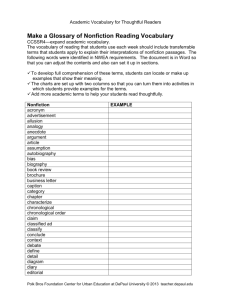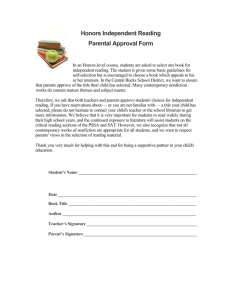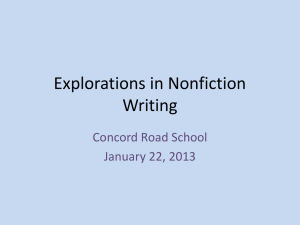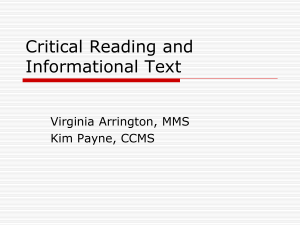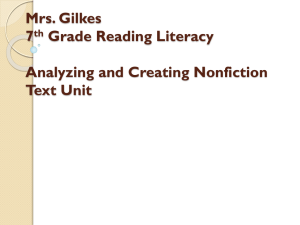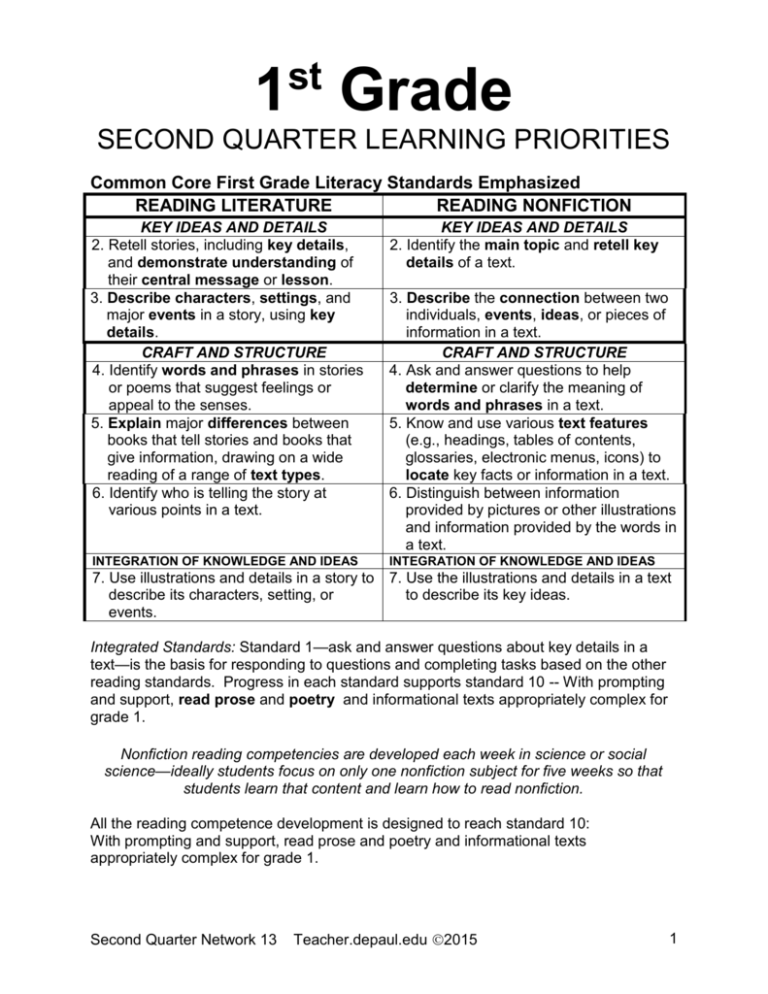
st
1 Grade
SECOND QUARTER LEARNING PRIORITIES
Common Core First Grade Literacy Standards Emphasized
READING LITERATURE
READING NONFICTION
KEY IDEAS AND DETAILS
2. Retell stories, including key details,
and demonstrate understanding of
their central message or lesson.
3. Describe characters, settings, and
major events in a story, using key
details.
CRAFT AND STRUCTURE
4. Identify words and phrases in stories
or poems that suggest feelings or
appeal to the senses.
5. Explain major differences between
books that tell stories and books that
give information, drawing on a wide
reading of a range of text types.
6. Identify who is telling the story at
various points in a text.
KEY IDEAS AND DETAILS
2. Identify the main topic and retell key
details of a text.
3. Describe the connection between two
individuals, events, ideas, or pieces of
information in a text.
CRAFT AND STRUCTURE
4. Ask and answer questions to help
determine or clarify the meaning of
words and phrases in a text.
5. Know and use various text features
(e.g., headings, tables of contents,
glossaries, electronic menus, icons) to
locate key facts or information in a text.
6. Distinguish between information
provided by pictures or other illustrations
and information provided by the words in
a text.
INTEGRATION OF KNOWLEDGE AND IDEAS
INTEGRATION OF KNOWLEDGE AND IDEAS
7. Use illustrations and details in a story to
describe its characters, setting, or
events.
7. Use the illustrations and details in a text
to describe its key ideas.
Integrated Standards: Standard 1—ask and answer questions about key details in a
text—is the basis for responding to questions and completing tasks based on the other
reading standards. Progress in each standard supports standard 10 -- With prompting
and support, read prose and poetry and informational texts appropriately complex for
grade 1.
Nonfiction reading competencies are developed each week in science or social
science—ideally students focus on only one nonfiction subject for five weeks so that
students learn that content and learn how to read nonfiction.
All the reading competence development is designed to reach standard 10:
With prompting and support, read prose and poetry and informational texts
appropriately complex for grade 1.
Second Quarter Network 13
Teacher.depaul.edu 2015
1
Writing: CCSSW.1.2 EXPLANATORY (CPS Framework Assessment Specification)
Write explanatory texts in which they recount two or more appropriately sequenced
events, include some details regarding what happened, use temporal words to signal
event order, and provide some sense of closure
Explanatory writing aligns with reading standard 7—integrate from different sources;
and writing standard 7—research to understand a topic.
The Speaking and Listening Standards are Keys to
Learning ACROSS the Curriculum
Comprehension and Collaboration
SL.1.1 Participate in collaborative conversations with diverse partners about
grade 1 topics and texts with peers and adults in small and larger groups.
__SL.1.1a Follow agreed-upon rules for discussions (e.g., listening to others
with care, speaking one at a time about the topics and texts under
discussion).
__SL.1.1b Build on others’ talk in conversations by responding to the
comments of others through multiple exchanges.
__SL.1.1c Ask questions to clear up any confusion about the topics and texts
under discussion.
SL.1.2 Ask and answer questions about key details in a text read aloud or
information presented orally or through other media.
SL.1.3 Ask and answer questions about what a speaker says in order to
gather additional information or clarify something that is not understood.
Presentation of Knowledge and Ideas
SL.1.4 Describe people, places, things, and events with relevant details,
expressing ideas and feelings clearly.
SL.1.5 Add drawings or other visual displays to descriptions when appropriate
to clarify ideas, thoughts, and feelings.
SL.1.6 Produce complete sentences when appropriate to task and situation.
Students exercise Speaking and Listening competencies as they proceed through
the gradual release of responsibility.
Integrate the Conventions in Writing and Speaking
SOURCE of Common Core Standards cited in this guide: http://www.corestandards.org
Second Quarter Network 13
Teacher.depaul.edu 2015
2
The standards have been issued with a public license that allows them to be republished for any purpose
that supports the standards initiative. © Copyright 2010. National Governors Association Center for Best
Practices and Council of Chief State School Officers. All rights reserved.
LANGUAGE
First Grade
These lists are set up with lines so that you can check your students’ learning
priorities for this quarter.
CONVENTIONS IN WRITING AND SPEAKING
1. Observe conventions of grammar and usage.
__a. Print all upper- and lowercase letters.
__b. Use singular and plural nouns with matching verbs in simple sentences (e.g., He hops; We
hop).
__c. Use subject, object, and possessive pronouns in speaking and writing (e.g., I, me, my; they,
them, their).
__d. Use verbs to convey a sense of past, present, and future in writing and speaking (e.g.,
Yesterday I walked home; Today I walk home; Tomorrow I will walk home).
__e. Understand and use frequently occurring prepositions in English (e.g., during, beyond, toward).
__f. Produce and expand complete declarative, interrogative, imperative, and exclamatory
sentences in response to questions and prompts.
__g. Understand that, minimally, every sentence must be about something (the subject) and tell
something (the predicate) about its subject.
2. Observe conventions of capitalization, punctuation, and spelling.
__a. Capitalize names, places, and dates.
__b. Use end punctuation for sentences, including periods, question marks, and exclamation points.
__c. Use commas in dates and to separate single words in a series.
__d. Use conventional spelling for words with common spelling patterns and for common irregular
words.
__e. Use phonetic spellings for untaught words, drawing on phonemic awareness and spelling
conventions.
__f. Form new words through addition, deletion, and substitution of sound and letters (e.g., an →
man → mat → mast → must → rust → crust).
3. (Beings in grade 3)
VOCABULARY ACQUISITION AND USE
4. Determine word meanings (based on grade 1 reading).
__a. Sort words into categories (e.g., colors, clothing) to gain a sense of the concepts the categories
represent.
__b. Use sentence-level context as a clue to the meaning of an unknown word.
__c. Use common affixes in English as a clue to the meaning of an unknown word.
__d. Define words by category and by one or more key attributes (e.g., a duck is a bird that swims; a
tiger is a large cat with stripes).
__e. Demonstrate understanding of the concept of multiple-meaning words (e.g., match, kind, play)
by identifying meanings of some grade-appropriate examples of such words.
5. Understand word relationships.
__a. Build real-life connections between words and their use (e.g., note places at home that are
cozy).
__b. Distinguish shades of meaning among verbs differing in manner (e.g., look, peek, glance, stare,
glare, scowl) and adjectives differing in intensity (e.g., large, gigantic) by defining, choosing, or
acting out the meanings.
6. Use newly learned words acquired through conversations, reading, and responding to texts.
Second Quarter Network 13
Teacher.depaul.edu 2015
3
First Grade: Second Quarter, Weeks 11-12 Learning Priorities
LITERATURE AND FOUNDATIONAL SKILLS
Literature Genre
Reading
Literature
CCSSRL.1.3
Describe
characters,
settings, and
major events in a
story, using key
details.
Week of November 16 Include
response to REACH assessment
__fairy tale __folk tale
__realistic fiction __fable
__ ______________________
Week of November 23
Identify/draw characteristics
of persons in a story/situation
Infer traits from actions.
How they feel
What their traits are and how
they are different from
feelings
How their traits are shown in
their actions.
Identify/draw characteristics
of persons in a
story/situation
Infer traits from actions.
How they feel
What their traits are
How their traits are shown in
their actions.
Question answer
feeling
trait
evidence
__fairy tale __folk tale
__realistic fiction __fable
__ ______________________
Question answer
feeling
trait
evidence
Word Patterns
and Grammar
In addition to
scheduled sight
words include
phrases such as
the Fry Phrases.
Sight Words
Sight Words
PHONICS:
PHONICS:
Writing
CCSSW1.2
Explanatory/
informational
Write sentence with question
mark. Then write sentence
with period that answers the
question.
Write sentence with question
mark. Then write sentences
with period that answer the
question.
Write journal (ongoing)
Primary Reading Resources
Vocabulary and Reading Resources
Primary Writing Guides
Second Quarter Network 13
Teacher.depaul.edu 2015
4
First Grade: Second Quarter, Weeks 11-12 Learning Priorities
NONFICTION LITERACY IN SCIENCE AND SOCIAL SCIENCE
Week of November 16 Include
response to REACH assessment
Nonfiction
Sources
Week of November 23
_ picture book _big book
__history
_topic book _ biography __video
__museum exhibit
_ picture book _big book
__history
_topic book _ biography
__video
__museum exhibit
Science and
Integrate NONFICTION reading Integrate NONFICTION
Social Science
and visual resources to
reading and visual resources
DEVELOP
explore a topic with a Focus
to explore a topic with a
NONFICTION
Question.
Focus Question.
Make picture glossary
Make picture glossary
LITERACY
read, experience, draw, list
read, experience, draw, list
CCSSRI.1.2—
facts about topic to answer a
facts about topic to answer
locate information
FOCUS QUESTION .
a FOCUS QUESTION .
then 1.3
Relate information Classify information and
Classify information and
to an idea; Classify
tell how you do it
tell how you do it
information
Second Quarter Network 13
Teacher.depaul.edu 2015
5
First Grade: Second Quarter, Weeks 13-14 Learning Priorities
LITERATURE AND FOUNDATIONAL SKILLS
Week of November 30
Literature Genre
Week of December 7
__fairy tale __folk tale
__realistic fiction __fable
__ ______________________
__fairy tale __folk tale
__realistic fiction __fable
__ ______________________
Reading
Read a poem and draw what
Literature
the words help you
CCSSRL1.4
understand or feel.
Identify words
and phrases in
stories or poems
that suggest
feelings or appeal
to the senses.
Read a poem and draw what
it means.
Word Patterns
and Grammar
In addition to
scheduled sight
words include
phrases such as
the Fry Phrases.
2-letter consonant blends
Sight Words
2-letter consonant blends
Sight Words
PHONICS:
PHONICS:
Writing
CCSSW1.2
Explanatory/
Informational
Write sentences with
question mark, period,
exclamation mark.
Write sentences with question
mark, period, exclamation
mark.
Primary Reading Resources
Vocabulary and Reading Resources
Primary Writing Guides
Second Quarter Network 13
Teacher.depaul.edu 2015
6
First Grade: Second Quarter, Weeks 13-14 Learning Priorities
NONFICTION LITERACY IN SCIENCE AND SOCIAL SCIENCE
Nonfiction
Sources
Science and
Social Science
DEVELOP
NONFICTION
LITERACY
CCSSRI1.2
identify idea and
support with
information from
text and visual
(1.3 and 1.7)
Week of November 30
Week of December 7
_ picture book _big book
__history
_topic book _ biography
__video
__museum exhibit
Integrate NONFICTION reading
and visual resources to
explore a topic with a Focus
Question.
Make picture glossary based
on two different sources
about same topic
read, experience, draw, list
facts about topic to answer a
FOCUS QUESTION .
Summarize what you
learned.
_ picture book _big book
__history
_topic book _ biography __video
__museum exhibit
Second Quarter Network 13
Integrate NONFICTION reading
and visual resources to explore
a topic with a Focus Question.
Make picture glossary based
on two different sources about
same topic
read, experience, draw, list
facts about topic to answer a
FOCUS QUESTION
Summarize what you learned.
Teacher.depaul.edu 2015
7
First Grade: Second Quarter, Weeks 15-16 Learning Priorities
LITERATURE AND FOUNDATIONAL SKILLS
Week of December 14
Literature Genre
__fairy tale __folk tale
__realistic fiction __fable
__
______________________
Reading Literature Identify sequence in a
CCSSRL1.2 theme
story or event
CCSSRL1.3
Events
characters, events,
purpose
Week of January 4
__fairy tale __folk tale
__realistic fiction __fable
__ ______________________
Identify sequence in a story or event
Events
Draw and write to show what
Draw and write to show what
happens that is important to
happens that is important to
understand the message
understand the message
Sight Words
Word Patterns and Sight Words
Grammar
In addition to
scheduled sight
words include
phrases such as the
PHONICS:
Fry Phrases.
PHONICS:
Writing
CCSSW1.2
Explanatory/
informational
Write sentences with
pronoun
Write sentences with pronoun
Primary Reading Resources
Vocabulary and Reading Resources
Primary Writing Guides
Second Quarter Network 13
Teacher.depaul.edu 2015
8
First Grade: Second Quarter, Weeks 15-16 Learning Priorities
NONFICTION LITERACY IN SCIENCE AND SOCIAL SCIENCE
Nonfiction
Sources
Science and
Social Science
DEVELOP
NONFICTION
LITERACY
CCSSRI1.2 identify
idea and support
with information
from text and visual
(1.3 and 1.7)
Week of December 14
_ picture book _big book
__history
_topic book _ biography
__video
__museum exhibit
Integrate NONFICTION
reading and visual
resources to explore a
topic with a Focus
Question.
list words and pictures
that help you figure out
important information.
Tell an idea about the
topic based on a
nonfiction text. Tell
how the writer uses
words, pictures,
sentences, questions
to help you understand
it.
Second Quarter Network 13
Week of January 4
_ picture book _big book __history
_topic book _ biography __video
__museum exhibit
Integrate NONFICTION reading and
visual resources to explore a topic
with a Focus Question.
list words and pictures that help you
summarize what you learn
Tell an idea about the topic based on
a nonfiction text. Tell how the
writer uses words, pictures,
sentences, questions to help you
understand it.
Teacher.depaul.edu 2015
9
First Grade: Second Quarter, Weeks 17-18 Learning Priorities
LITERATURE AND FOUNDATIONAL SKILLS
Week of January 11
Literature
Genre
Reading
Literature
CCSSRL.1.1
Analyze, then
infer; answer
with evidence
__fairy tale __folk tale
__realistic fiction __fable
__ ______________________
Analyze questions, respond
thoughtfully
Ask/answer what/where
questions—point out these
are literal.
Question Answer Where
I find it
Ask/answer inferential
questions
Question Answer Why I
think it
Word Patterns Sight Words
and Grammar
In addition to
scheduled sight
words include
phrases such as
the Fry Phrases. PHONICS:
Writing
CCSSW1.2
Explanatory/
informational
Write explanation
Week of January 18
__fairy tale __folk tale
__realistic fiction __fable
__ ______________________
Analyze questions, respond
thoughtfully
Ask/answer what/where questions—
point out these are literal.
Question
Answer
Where I
find it
Ask/answer inferential questions
Question Answer
Why I think it
Sight Words
PHONICS:
Write explanation
Primary Reading Resources
Vocabulary and Reading Resources
Primary Writing Guides
Second Quarter Network 13
Teacher.depaul.edu 2015
10
First Grade: Second Quarter, Weeks 17-18 Learning Priorities
NONFICTION LITERACY IN SCIENCE AND SOCIAL SCIENCE
Nonfiction
Sources
Science and
Social Science
DEVELOP
NONFICTION
LITERACY
Locate
information
CCSSRI1.2
explain an idea
with information
from pictures
and visuals
CCSSRI1.3 and
1.7
Week of January 11
_ picture book _big book
__history
_topic book _ biography
__video
__museum exhibit
Integrate NONFICTION
reading and visual resources
to explore a topic with a
Focus Question.
Make glossary
List information to support
an idea
Identify source of
information
Compare and contrast how
a writer and an
illustrator/photographer
provide information
Second Quarter Network 13
Week of January 18
_ picture book _big book __history
_topic book _ biography __video
__museum exhibit
Integrate NONFICTION reading and
visual resources to explore a topic
with a Focus Question.
Make glossary
List information to support an idea
Identify source of information
Compare and contrast how a writer
and an illustrator/photographer
provide information
Teacher.depaul.edu 2015
11
First Grade: Second Quarter, Weeks 19-20 Learning Priorities
LITERATURE AND FOUNDATIONAL SKILLS
Week of January 25
Week of February 1: Comprehensive
Assessment
Literature Genre
__fairy tale __folk tale
__realistic fiction __fable
__ ______________________
__fairy tale __folk tale
__realistic fiction __fable
__ ______________________
Reading
Literature
CCSSRL.1.2—
identify theme
CCSSRL3—
analyze
development in a
story
Analyze how a character
changes in a story.
What the character learns.
How the character’s
choices lead the character
to change or learn.
Relate to the theme of the
story.
Analyze how a character changes in
a story.
Relate to the theme of the story.
Revisit stories read this quarter
and see how the writer uses the
character’s change to help you
understand the theme or
message of the story.
Word Patterns
and Grammar
In addition to
scheduled sight
words include
phrases such as
the Fry Phrases.
Sight Words
Sight Words
Use sight words to write sentences.
Make sight word “banks” that
include different kinds of sight words
such as action words, nouns,
adjectives.
PHONICS:
PHONICS:
Make a chart showing all the
phonics you have learned this
semester,
Writing
explanatory/
informational
Write and illustrate an
explanation.
Write and illustrate an
explanation
Primary Reading Resources
Vocabulary and Reading Resources
Primary Writing Guides
Second Quarter Network 13
Teacher.depaul.edu 2015
12
First Grade: Second Quarter, Weeks 19-20 Learning Priorities
NONFICTION LITERACY IN SCIENCE AND SOCIAL SCIENCE
Week of January 25
Nonfiction
Sources
_ picture book _big book
__history
_topic book _ biography
__video
__museum exhibit
Science and
Integrate NONFICTION
Social Science
reading and visual resources
to explore a topic with a
DEVELOP
Focus Question.
NONFICTION
read, experience, draw, list
LITERACY
facts, write/tell about a topic
Locate information Make a poster or booklet or
CCSSRI1.2
page that tells/shows an
explain an idea
important idea you have
with information
learned.
from pictures and
visuals
CCSSRI1.3 and
1.7
Second Quarter Network 13
Week of February 1:
Comprehensive Assessment
_ picture book _big book __history
_topic book _ biography __video
__museum exhibit
Integrate NONFICTION reading
and visual resources to explore a
topic with a Focus Question.
read, experience, draw, list facts,
write/tell about a topic
Make a poster or booklet or page
that tells/shows an important
idea you have learned.
Teacher.depaul.edu 2015
13


